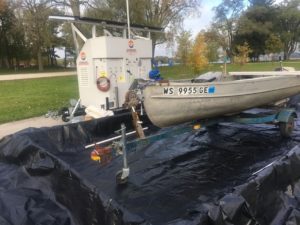A research project recently completed by Wisconsin Sea Grant found that there was no statistical difference between an experienced watercraft inspector removing aquatic plants and small-bodied invertebrates from a watercraft using hand removal or using a CD3 waterless watercraft cleaning system. There was also no difference related to cleaning treatment duration. Study results are available in a recently finalized Wisconsin Sea Grant report authored by Tim Campbell, Molly Bodde and Titus Seilheimer.

A CD3 waterless watercraft cleaning system is used to clean a small boat during an experimental trial. (Photo: Molly Bodde)
Experimental trials consisted of a researcher placing a known amount of Eurasian watermilfoil or a mixture of spiny water fleas and wetland plant seeds on a watercraft. Then the inspector used each cleaning treatment for 90 or 180 seconds. The researcher then collected the removed specimens and recovered the remaining specimens to determine the percentage of specimens removed for each trial.
The same inspector completed every trial—a trained Wisconsin Clean Boats, Clean Waters inspector with two summers of inspection experience. The inspector did not have any previous experience with the CD3 cleaning system.
A key finding from the study was that a trained, experienced inspector can be very effective removing plants and small-bodied organisms from watercraft, with the inspector removing between 93 to 99 percent of aquatic plants and 80 to 92 percent of small-bodied invertebrates with the treatments, with no statistical difference between the methods.
Compared to a previous, similar study that also used a trained inspector (but not a CD3 system for comparison), these new results show a slightly higher removal effectiveness. Future research should investigate the roles that training and experience have in the ability of inspectors and boaters to remove aquatic plants and small-bodied invertebrates from watercraft.
For more information, contact Aquatic Invasive Species Outreach Specialist Tim Campbell or Southeast Wisconsin Aquatic Invasive Species Outreach Specialist Molly Bodde.





